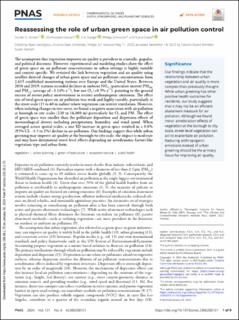| dc.contributor.author | Venter, Zander | |
| dc.contributor.author | Hassani, Amirhossein | |
| dc.contributor.author | Stange, Erik | |
| dc.contributor.author | Schneider, Philipp | |
| dc.contributor.author | Castell, Nuria | |
| dc.date.accessioned | 2024-02-16T09:44:40Z | |
| dc.date.available | 2024-02-16T09:44:40Z | |
| dc.date.created | 2024-01-30T12:01:05Z | |
| dc.date.issued | 2024 | |
| dc.identifier.citation | Proceedings of the National Academy of Sciences of the United States of America. 2024, 121, e2306200121. | en_US |
| dc.identifier.issn | 0027-8424 | |
| dc.identifier.uri | https://hdl.handle.net/11250/3118112 | |
| dc.description.abstract | The assumption that vegetation improves air quality is prevalent in scientific, popular, and political discourse. However, experimental and modeling studies show the effect of green space on air pollutant concentrations in urban settings is highly variable and context specific. We revisited the link between vegetation and air quality using satellite- derived changes of urban green space and air pollutant concentrations from 2,615 established monitoring stations over Europe and the United States. Between 2010 and 2019, stations recorded declines in ambient NO2, (particulate matter) PM10, and PM2.5 (average of −3.14% y−1), but not O3 (+0.5% y−1), pointing to the general success of recent policy interventions to restrict anthropogenic emissions. The effect size of total green space on air pollution was weak and highly variable, particularly at the street scale (15 to 60 m radius) where vegetation can restrict ventilation. However, when isolating changes in tree cover, we found a negative association with air pollution at borough to city scales (120 to 16,000 m) particularly for O3 and PM. The effect of green space was smaller than the pollutant deposition and dispersion effects of meteorological drivers including precipitation, humidity, and wind speed. When averaged across spatial scales, a one SD increase in green space resulted in a 0.8% (95% CI: −3.5 to 2%) decline in air pollution. Our findings suggest that while urban greening may improve air quality at the borough- to- city scale, the impact is moderate and may have detrimental street- level effects depending on aerodynamic factors like vegetation type and urban form. vegetation | urban planning | green infrastructure | ecosystem service | public health | en_US |
| dc.language.iso | eng | en_US |
| dc.rights | Navngivelse 4.0 Internasjonal | * |
| dc.rights.uri | http://creativecommons.org/licenses/by/4.0/deed.no | * |
| dc.title | Reassessing the role of urban green space in air pollution control | en_US |
| dc.title.alternative | Reassessing the role of urban green space in air pollution control | en_US |
| dc.type | Peer reviewed | en_US |
| dc.type | Journal article | en_US |
| dc.description.version | publishedVersion | en_US |
| dc.rights.holder | © 2024 the Author(s). Published by PNAS. | en_US |
| dc.subject.nsi | VDP::Matematikk og naturvitenskap: 400 | en_US |
| dc.subject.nsi | VDP::Mathematics and natural scienses: 400 | en_US |
| dc.subject.nsi | VDP::Matematikk og naturvitenskap: 400 | en_US |
| dc.subject.nsi | VDP::Mathematics and natural scienses: 400 | en_US |
| dc.source.volume | 121 | en_US |
| dc.source.journal | Proceedings of the National Academy of Sciences of the United States of America | en_US |
| dc.source.issue | 6 | en_US |
| dc.identifier.doi | 10.1073/pnas.2306200121 | |
| dc.identifier.cristin | 2238204 | |
| dc.relation.project | Norges forskningsråd: 326641 | en_US |
| dc.relation.project | NILU: SIS- EO (NILU #B121004) | en_US |
| dc.source.articlenumber | e2306200121 | en_US |
| cristin.ispublished | true | |
| cristin.fulltext | original | |
| cristin.qualitycode | 2 | |

